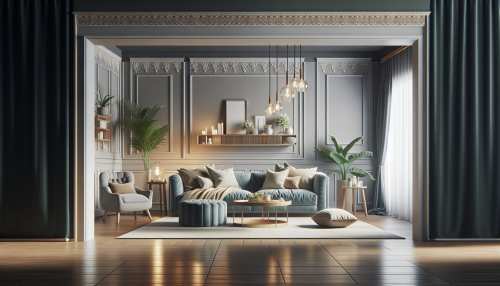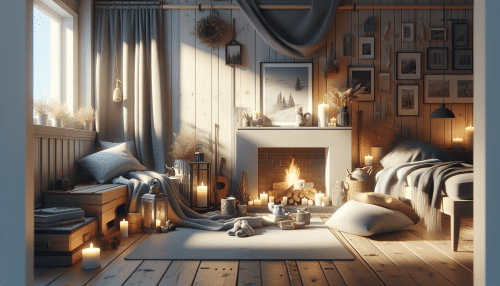Smart Ways You Can Upgrade Home Ambiance Easily
Olivia Morgan November 2, 2025
Discover engaging and actionable ideas to enhance your home’s ambiance using clever lifestyle inspirations. Whether exploring mood lighting, decluttering, or integrating biophilic design, you’ll uncover practical techniques that can transform your living space in unexpected ways. Explore how small changes can lead to uplifting results, making comfort and style part of everyday life.
Understanding Home Ambiance and Its Influence
Home ambiance is more than just a buzzword—it’s the invisible layer that shapes how dwellers and guests feel from the entrance to every room. Effective ambiance curation combines elements like lighting, scent, and arrangement to create a sanctuary reflecting personality and purpose. Research from environmental psychology suggests that subtle shifts in home energy can improve relaxation and support overall well-being. Understanding the fundamentals of ambiance helps focus your upgrades on what truly matters, influencing mood and making ordinary moments memorable.https://www.apa.org/pi/about/publications/caregivers/practice-settings/home/psychology
Modern living often places people in diverse environments—busy workspaces, crowded public spots, or digital landscapes. Returning home should reset that dynamic. By rethinking the arrangement of favorite furniture or the placement of decorative objects, it’s possible to transform any interior without an expensive overhaul. These subtle cues—like the warmth of soft rugs, inviting art, or even background music—reshape the perception of comfort and security. Such details often go unnoticed but play a significant part in daily happiness.
Achieving a welcoming ambiance is accessible for households of all sizes and budgets. Some choose to experiment with affordable smart lighting, while others bring in nature-inspired design through plants or open windows for ventilation. Each micro-upgrade, from scent diffusers to curated bookshelf displays, can influence energy. Small changes accumulate, often leading to profound improvements in how individuals unwind, work, or socialize within their homes. The journey to ambiance is unique for every lifestyle, but guidance helps navigate countless creative choices.
Mood Lighting: Easy Solutions with Big Impact
Lighting is a powerful tool in setting the scene. The interplay of natural and artificial light directly affects mood, sleep quality, and productivity at home. Adjustable lights can mimic daylight or create cozy nooks for winding down after a long day. Choosing layering—overhead fixtures, floor lamps, and soft accent lights—makes rooms adapt to various needs. Smart bulbs are growing in popularity for their flexibility, allowing users to switch tones or brightness with a tap. This flexible control helps set the right mood for every occasion.https://www.sleepfoundation.org/bedroom-environment/how-light-affects-sleep
Accent lighting, such as LED strips behind shelves or spotlights on treasured art, can provide drama and warmth. Dimmer switches offer further flexibility, giving residents control to tailor their environment for focused work or relaxing media nights. Positioning lights at different heights—table lamps, wall sconces, or under-cabinet strips—creates layers of interest. Solutions are plenty, from battery-powered fairy lights to sunrise alarm clocks that gently brighten rooms each morning. These choices enable ongoing experimentation and adaptation as tastes change.
Don’t underestimate the impact of natural variations. Letting in daylight via sheer curtains or skylights not only enhances energy but helps regulate natural sleep patterns. For those in darker climates, light therapy lamps can balance circadian rhythms. Where practical, combining multiple light sources ensures every activity—reading, dining, entertaining, or meditating—takes place in an ambiance that boosts comfort. One solution rarely fits all rooms, so flexibility should guide your upgrades, making the most of resources and unique preferences.
Embracing Minimalism and Decluttering
Minimalism is not about living with less, but living with purpose. The philosophy behind minimal home design focuses on paring down possessions and letting key pieces breathe, giving space for natural light and positive energy. Decluttering helps diminish stress and fosters a sense of control. Studies by leading wellness experts suggest a tidy room can improve concentration, sleep, and even self-esteem. It’s an attainable transformation—one shelf or closet at a time—cultivating clarity and balance throughout your space.https://www.ncbi.nlm.nih.gov/pmc/articles/PMC5579396/
For many households, starting small makes minimalism manageable. Begin with high-traffic areas like entryways, kitchens, or living rooms, removing duplicates and sorting items into keep, donate, or recycle categories. Enjoy the process of organizing, rediscovering old treasures, and letting go of seldom-used objects. Creating designated spaces for frequently used belongings fosters efficiency, avoiding lost time searching for items. These actions also pave the way for creative reorganizations—using baskets, open shelving, or multipurpose furniture for better flow and visual calm.
Decluttering often inspires a ripple effect, encouraging healthier buying habits and a sustained sense of gratitude for what’s kept. Instead of filling every nook, let neutral walls or open corners provide depth. Incorporate accent pieces mindfully—favorite vases, textiles, or houseplants—to personalize but not crowd. Minimal design is dynamic and forgiving; it enables home environments to evolve. Over time, spaces feel more expansive and serene. Even a single room’s reorganization can spark motivation to continue simplifying and upgrading home ambiance.
Biophilic Design: Bringing Nature Indoors
Biophilic design highlights the innate human affinity for nature. Integrating plants, natural materials, and organic shapes into interiors is more than décor—it’s a health-positive strategy. Studies from environmental researchers show greenery relieves stress, purifies air, and enhances creativity. Low-maintenance houseplants, vertical gardens, and wooden accents add beauty and foster a sense of connection to the natural world. It’s possible to create a sanctuary at home, even in urban settings, with well-chosen greenery.https://www.archdaily.com/940454/biophilic-design-bringing-nature-into-our-built-environment
Natural textures—stone countertops, wool throws, or bamboo blinds—bring sensory warmth and subtle variety. Including water features, such as tabletop fountains or aquariums, introduces soothing sounds and gentle motion. Consider placing mirrors across from windows to bounce natural light deep into living areas, maximizing sunlight’s nurturing benefits. Use botanical prints, earth-toned color palettes, or pebble displays to evoke calming landscapes even where real plants can’t thrive. Biophilic touches work well in bedrooms, studies, or living rooms.
For those less comfortable with live plants, artificial alternatives or preserved moss walls provide aesthetic value without maintenance concerns. Natural scents via essential oils or beeswax candles further evoke tranquil woodland or herbal gardens. Incorporate these elements gradually, layering them into existing décor. As biophilic features become central to daily living, their positive effects become evident—boosted mood, cleaner air, and a deeper sense of relaxation. Creative exploration allows residents to customize the natural balance suited for their lifestyle and locality.
Enhancing Home Ambiance Through Scent and Sound
Scent is a subtle yet crucial element for nurturing the home environment. Fragrances can uplift, energize, or calm depending on their origin and profile. Citrus, lavender, or cedar are popular choices for their ability to enhance focus, rest, or sociability. Scented candles, essential oil diffusers, or simmer pots each provide routes to curated aroma. Research links calming scents to positive effects on relaxation and sleep quality, while uplifting blends can counteract fatigue.https://www.ncbi.nlm.nih.gov/pmc/articles/PMC5198031/
Soundscapes—ambient music, gentle white noise, or meditative audio—further influence how a room feels. Custom playlists or streaming noise generators can weaken the impact of street noise, boosting privacy and concentration. Wind chimes or water features introduce dynamic, nature-inspired tunes, creating harmony indoors. Thoughtful noise management improves productivity and helps transition between work, leisure, and rest. Experimenting with various sonic elements allows spaces to support a range of moods from energizing to restful.
Combining scent and sound amplifies positive ambiance. Consider themed environments: rainforest scents with soft rain tracks, or citrus and jazz for social gatherings. Flexible approaches, such as seasonal changes or scent swaps between rooms, enhance ongoing satisfaction. The power of aroma and acoustics means even modest upgrades—switching up a scent or rotating playlists—can refresh the home atmosphere, supporting both mental and emotional well-being. Individual or shared routines help cultivate spaces tailored to every moment.
Personalized Touches: Art, Textiles, and Color Psychology
Personalizing space is an art. Whether through cherished art, photos, or handcrafted accents, these touches help a house feel truly like home. Artwork can inspire creativity or calm, with bold pieces energizing shared rooms and serene landscapes winding down personal corners. Layering with textiles—soft throws, patterned rugs, or fabric wall hangings—provides visual comfort and sound absorption. Together, these choices infuse rooms with character and meaning beyond surface decoration.https://www.psychologytoday.com/us/blog/the-art-motivation/201501/how-art-changes-us
Color psychology is a time-tested guide. Soft blues and greens often evoke peace and relaxation, while yellows and oranges encourage optimism and warmth. Selecting paint or accent colors with care can create zones—productive corners, social hubs, or sleep-friendly sanctuaries. Mixing textures, hues, and materials breaks up monotony, inviting exploration and interaction. Even temporary upgrades like peel-and-stick wallpaper or colorful throws can dramatically shift perceptions without permanent commitment.
The journey of personalizing a home is ongoing. Rotate art, rearrange books, or switch cushion covers for seasonal updates. Involve household members by featuring their creations or favorite finds. This practice strengthens a sense of belonging and encourages shared pride in the living space. Authentic self-expression remains the cornerstone of ambiance—rooms that spark joy, reflection, or laughter make everyday routines richer. Let the small details speak volumes about passions, journeys, and dreams.
References
1. American Psychological Association. (n.d.). The Role of Psychology in Home and Family Settings. Retrieved from https://www.apa.org/pi/about/publications/caregivers/practice-settings/home/psychology
2. Sleep Foundation. (n.d.). How Light Affects Sleep. Retrieved from https://www.sleepfoundation.org/bedroom-environment/how-light-affects-sleep
3. Saxbe, D. E., & Repetti, R. L. (2010). No Place Like Home: Home Tours Correlate With Daily Patterns of Mood and Cortisol. Retrieved from https://www.ncbi.nlm.nih.gov/pmc/articles/PMC5579396/
4. ArchDaily. (n.d.). Biophilic Design: Bringing Nature into Our Built Environment. Retrieved from https://www.archdaily.com/940454/biophilic-design-bringing-nature-into-our-built-environment
5. Lee, S.-Y., & Lee, J. (2016). Effects of Aromatherapy on Sleep Quality: A Systematic Review and Meta-Analysis. Retrieved from https://www.ncbi.nlm.nih.gov/pmc/articles/PMC5198031/
6. Gregory, A. (2015). How Art Changes Us. Psychology Today. Retrieved from https://www.psychologytoday.com/us/blog/the-art-motivation/201501/how-art-changes-us





